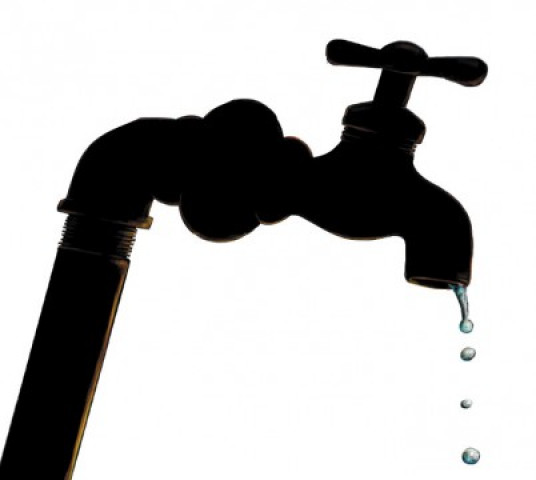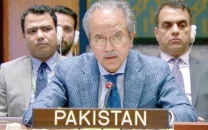Dry taps and open sewers: welcome to India's 'Millennium City'
Crippling power and water shortages and open sewage drains are an extreme example of the poor infrastructure.

Most days there is just a trickle of water from the taps and sometimes even that dries up before noon. The 56-year-old has often had to scurry to a neighbour across a potholed road to borrow a bucket of water and haul it back to her rented 300,000 home, sweat rolling down her face.
"Every morning I have to decide whether I want the upper half of my body clean or my lower half. With the amount of water we get, it's impossible to take a full-body bath," Kapoor said, sitting in her large, well-lit living room.
Welcome to Gurgaon, a city of wealthy urban professionals with gleaming shopping malls, five-star hotels and sprawling golf courses on the southern outskirts of New Delhi that is a symbol of newly affluent India.
But crippling power and water shortages, crater-riddled roads and open sewage drains have made it an extreme example of the poor infrastructure that is constraining growth in Asia's third-largest economy.
"Gurgaon is just a symbol of beautiful buildings. Otherwise it's rubbish," said PK Jain, the founder-president of the Gurgaon Chamber of Commerce and Industry. "Ultimately, the town is going to collapse."
Alongside the towering residential condominiums are glass and steel office blocks. The India offices of some of the world's best known companies are here, including Microsoft Corp , Google Inc. and agribusiness giant Cargill Inc.
But public infrastructure has failed to keep pace with the rapid growth unleashed by landmark economic reforms in 1991.
The provision of essential services is so bad that many companies and residents rely on expensive diesel generators to beat power cuts, pay private water tankers to deliver door-to-door when the taps run dry.
But demand outstrips supply, and with long power outages of up to eight hours a day, even well-off citizens are sometimes forced to have dinner by candlelight.
This week, residents erupted in anger over the lack of water and power during the hottest summer in the region for three decades. They took to the streets in protest and set tyres on fire to block traffic.
Nevertheless, Gurgaon has some of the fastest growing property prices in the world, with rates for some upscale homes nearly doubling to Rs21,000 ($380) a square foot in 2011 from about Rs11,000 in 2008, according to a report by Citibank.
At current prices, a 2,000 square foot apartment in those areas would cost $760,000. At the very top end, huge 5,500 square foot apartments set around a golf course sell for about $3 million.
Two Cities
Like many other Indian cities, Gurgaon is made up of two parts. The highway to New Delhi separates the new from the old, which is still a traditional market town serving farmers in the region.
The new Gurgaon shot up out of farmland two decades ago, mainly to cater to the overflowing population of the nearby capital. It is now India's third-wealthiest city by per-capita income, and its population has climbed to more than 1.5 million from just 900,000 in 2001.
Gurgaon has also become one of the hubs for the IT and outsourcing boom that drove India's economic growth from the 1990s, giving it the name "Millennium City".
Experts say the boom caught local authorities unawares, and they did not plan adequately for the power and water needs of a rapidly expanding population.
A company like DLF, which has been buying up chunks of land in Gurgaon since the 1970s to convert into residential compounds, commercial hubs and shopping centers, has set up its own private infrastructure network.
Pockets of Gurgaon developed by DLF have their own back-up power plant, water recycling systems and solar power heating.
"I don't think the government anticipated the level of growth or the problems that come with it and therefore, has no plan for it," Mohit Gujral, vice chairman and managing director of DLF India, told Reuters.
"We are changing the urban landscape of the city because we have been allowed to get involved."
DLF recently launched its own fire brigade equipped with Mercedes fire trucks imported from Finland. In a public-private partnership (PPP) with the state, it also started building a $100 million, 16-lane highway running through the city.
Vishwas Udgirkar, a senior director at consultants Deloitte India, believes Gurgaon's good security, recreational centres, shopping areas, eateries and cinema complexes attract more people and companies to the city every year.
"But come to the public infrastructure, it's pathetic," said Udgirkar, whose office is in the city.
"In terms of governance, again it's pathetic. I don't know who would still call it 'Millennium City'. It cannot be."
Waste Not, Want Not
This summer, with temperatures soaring to 47 degrees Celsius (117 F), Gurgaon residents grappled with the city's worst-ever power and water crisis as supplies fell to 15 percent of the normal volume.
In the city, pigs wallowed in fetid bug-infested ponds to beat the heat as huge billboard advertisements promised condominiums with 24-hour electricity and "world-class" facilities.
Every day, from the small hours of the morning to late in the night, residents uncoiled and hooked up water hoses linking private water tankers parked outside their homes to tanks inside, replacing the municipal water supply. Power supply has been similarly erratic.
As has happened in much of India, red tape has held up coal supplies to power plants that supply Gurgaon's electricity.
Technical glitches have caused more disruptions.
In one of Gurgaon's most upscale neighbourhoods, a row of cars, including two BMWs, glistens in the sun outside a three-storey bungalow. But Purushotam, the caretaker of the household, said on some days he barely got a full bucket of water to clean the luxury cars.
"We don't have enough water to drink, how can we take elaborate baths and clean the cars? Water is like gold to us now," he chuckled.
For the thousands of migrants eking out a living in Gurgaon, working at construction sites or as household servants, life is even tougher as they are priced out of basic services that the private sector provides.
"The diesel generators are too expensive. And we don't even go to the air-conditioned malls for respite," said Naresh Kumar, who earns $150 a month as a water delivery man and says he cannot afford the fare to go to the city's shopping district.
Gurgaon, the 'America' of India?
Many of Gurgaon's problems - a lack of administrative will, shoddy infrastructure and a lackadaisical attitude to civic services - are reflected across India.
Although the country has some state-of-the-art airports, multi-billion dollar national highways and a Formula One race track, much of its existing infrastructure has been unable to cope, and slums are mushrooming next to highrises in its cities.
Facing a barrage of criticism over his government's handling of the economy, Prime Minister Manmohan Singh in June promised to help resuscitate the country's slumping growth by fast-tracking more than 200 key infrastructure projects.
New Delhi hopes to invest $1 trillion to beef up India's infrastructure over the next five years. But the unleveled roads and heaps of garbage lying in the empty housing lots of Gurgaon reflect how far India has to go.


















COMMENTS
Comments are moderated and generally will be posted if they are on-topic and not abusive.
For more information, please see our Comments FAQ